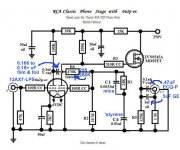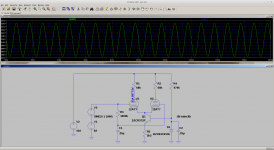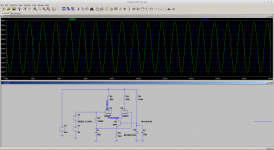The value of C1 is rather low too. Try something like 150pF to bring the dominate pole down to 10KHz.
I totally agree here with "Eli Duttman". The 12AX7 is simply not a beefy enough tube for this application. It works but sor of. You would get a real improvement if you were to buy a cheap 12AU7 and mod the resistor values. I dont think a CCS would really be the best solution but you can try that aswell. I do recommend using two depletion mosfets connected back to back. Easy to do but that component he mentioned isnt a bad choice either I just wonder whats the availabillity of it
The triode found in the 12AU7/ECC82 is non-linear and I regard it as suitable only for cathode follower and "concertina" phase splitter duty. A medium μ triode that both pins out the same as the 12A_7 bunch and is linear is the 12BH7. Watch out for the doubled heater current draw.
Mouser has over 800 pieces on hand of the TO220 case version of the 10M45S.
Mouser has over 800 pieces on hand of the TO220 case version of the 10M45S.
Some of these designs will be using the 'wimpy' 12AX7 poor drive and capacitance to create a dominate pole for the GNF. However there is a danger that you simply run out of drive at 10KHz.
Re CCS in the LTP tail: Yes, it is right that a CCS, due to it's high impedance, forces AC symmetry, even in a pair of rather dissimilar triodes. In parallel with this impedance are the CCS's internal capacitance and all stray capacitances of the wiring, the tube holder, the tube itself etc. The sum of these capacitances yields to an effective impedance at the cathodes that is inversely proportional with frequency. What do you think about that?
Best regards!
Best regards!
Practical experience shows CCS loading of LTP tails to be better than resistors. I suspect that even with frequency related variation in impedance the tail remains sufficiently "long".
If only a true infinite impedance tail load could be realized. Dream on foolish Eli.
If only a true infinite impedance tail load could be realized. Dream on foolish Eli.
Not exactly infinite, but in the MΩ range at least with a cascode CCS, as per Morgan Jones' suggestion, for instance.
Best regards!
Best regards!
instead of guessing.. does anyone have an idea or can point to the best long tail phase splitter of all there are? Best tubes for the job best schematic for the job. Lets find the best of all long tail phase inverters then
'Best' in which terms? Highest possible output levels? Lowest distortion? Lowest noise? Lowest effort?
Best regards!
Best regards!
since I am not a tube designer could someone scramble some values of resistors together for a phase splitter out of a 12BH7? 12BH7 are usually used as buffers when driving KT88 to almost 100W or any phisically big tube or a multitude of them. Could someone make a schematic of a DC coupled 12BH7 long tail inverter that would have 70-80V on the grids?
'Best' in which terms? Highest possible output levels? Lowest distortion? Lowest noise? Lowest effort?
Best regards!
Best of all. 😀
Output level would be something to beef too. And it drive power so it could controll maybe like KT88s or multitude of tubes.
Most of the time, the 12BH7 is a drop in replacement for the 12AU7 and parts value changes are not needed. THE issue is heater current availability.
Most of the time, the 12BH7 is a drop in replacement for the 12AU7 and parts value changes are not needed. THE issue is heater current availability.
Thats nice to hear. But could we really increase the max performance (in all regard mostly in term of drive level and drive power) . Like instead of drop it in and go lets optimise it to really squeeze all the performance out of it that there is
Last edited:
View attachment 842085
I could suggest that a 12AT7 has more gain than the 12AU7 and makes a good phase inverter. You could add a CCS in the cathodes if you wish.
That looks rather nice but I would like one with the 12BH7. Naturally I would think a tube with lower plate impedance would be able to drive awkward loads better. If you could do the same with a 12BH7 (and adjust the circuit to maximise the performance for that speciffic tube)
I dont think we would need that much gain in the inverter stage. The EF86 in its orginal config has way too much gain anyways.
Last edited:
I will definitely try that. I wish PCB based stuff was easy to mod 😀 . But I don't really care about visual quality in my prototype amp hah. If I would decrease the 2k2 resistor to the 1k5 what kind of drive level should I expect? (Max voltage swing into the output tubes). This would be nice to know since KT88 require a fair bit more drive than EL34 not just by more drive power but quite a lot more voltage aswell. Then I could put KT88s into the output change the bias resistor to 600ohms run it 500V and it could do 50W straight into the same transformer (assuming I can drive the EF86 hard enough which I can because I have a line level out from my computer that gives me a 2Vrms signal 😉 )
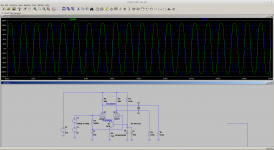
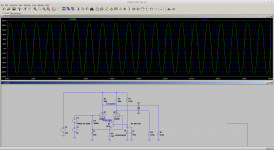
OK for KT88 cathode bias from data sheet R13=R14 = 270k therefore C6 C7 = 1uF on your schmatic.
You may want to add some 2k2 grid stoppers just in case. You may also add say 470r into base of NPN for same reason. NPN will need to dissipate 500mW and be high voltage. HFE is not that important.
The answer is loads of drive. You could even run the first stage at say 100v plate.
You may need the 16R tap on the transformer for KT88 to get most power.
The 12AT7 has more gain which means the first stage don't give as much distortion- but both work fine.
Last edited:
That looks rather great to me.
If you have the time could you also take a look at tht ECC99 from JJ. The say it's a preamp tube for 300B amps and I think from m experience it's a pretty large tube and it should do well aswell. Only if you have the time and the spice model. Many thanks for your help already
If you have the time could you also take a look at tht ECC99 from JJ. The say it's a preamp tube for 300B amps and I think from m experience it's a pretty large tube and it should do well aswell. Only if you have the time and the spice model. Many thanks for your help already
- Home
- Amplifiers
- Tubes / Valves
- Testing newly built mullard 5-20
